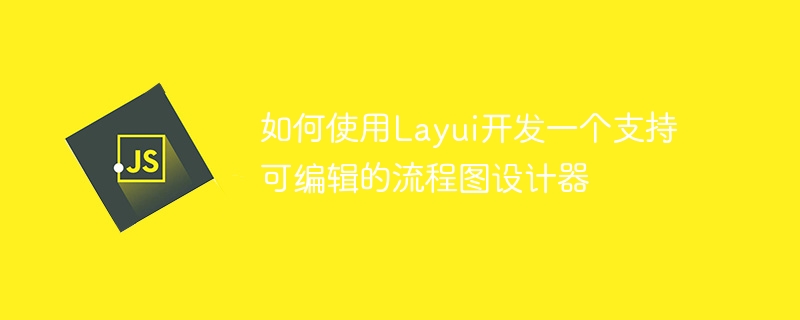

How to use Layui to develop a flowchart designer that supports editability
Introduction:
With the rapid development of informatization, flowcharts are used in all walks of life The applications in are becoming more and more widespread. However, the selection of flowchart editors currently on the market is limited, and most require payment. This article will introduce how to use the Layui framework to develop an editable flowchart designer and provide specific code examples.
1. Introduction to Layui:
Layui is a simple and easy-to-use front-end framework that provides a wealth of components and interfaces to quickly build a Web interface. It is characterized by lightweight, modularity, responsiveness, etc., which is very suitable for quickly developing simple web applications.
2. Design ideas:
The sample code is as follows:
The sample code is as follows:
layui.use(['jquery', 'layer'], function(){ var $ = layui.jquery; var layer = layui.layer; // 初始化工具栏按钮 $('#start').click(function(){ // 创建开始节点元素并在画布中显示 ... }); $('#process').click(function(){ // 创建流程节点元素并在画布中显示 ... }); $('#decision').click(function(){ // 创建决策节点元素并在画布中显示 ... }); // 初始化画布 var canvas = $('#canvas'); jsPlumb.ready(function(){ jsPlumb.setContainer(canvas); ... }); });
makeSourcemethod to make it draggable and themakeTargetmethod to make it connectable.The sample code is as follows:
// 创建开始节点元素 var start = $('开始'); canvas.append(start); jsPlumb.makeSource(start, { filter: '.node', anchor: 'Continuous', connectorStyle: { strokeStyle: '#999', lineWidth: 2 }, connectionType: 'basic', extract:{ "action":"the-action" }, maxConnections: 1, onMaxConnections: function(info, e) { layer.msg("不能再添加连接了!", {time: 1000}); } }).initDraggable(); // 创建流程节点元素 var process = $('流程节点'); canvas.append(process); jsPlumb.makeSource(process, { filter: '.node', anchor: 'Continuous', connectorStyle: { strokeStyle: '#999', lineWidth: 2 }, connectionType: 'basic', extract:{ "action":"the-action" }, maxConnections: -1, onMaxConnections: function(info, e) { layer.msg("不能再添加连接了!", {time: 1000}); } }).initDraggable(); // 创建决策节点元素 var decision = $('决策节点') canvas.append(decision); jsPlumb.makeSource(decision, { filter: '.node', anchor: 'Continuous', connectorStyle: { strokeStyle: '#999', lineWidth: 2 }, connectionType: 'basic', extract:{ "action":"the-action" }, maxConnections: -1, onMaxConnections: function(info, e) { layer.msg("不能再添加连接了!", {time: 1000}); } }).initDraggable();
connectmethod of the jsPlumb engine, we can achieve Connection lines between nodes. Right-click on the node, and a menu will pop up for the user to select the target node to connect to.The sample code is as follows:
canvas.on('contextmenu', '.node', function(e){ e.preventDefault(); var node = $(this); var menu = $(''); // 获取所有可连接的节点 var targets = canvas.find('.node').not(node); // 创建菜单项 targets.each(function(){ var target = $(this); var item = $('').text(target.text()); item.click(function(){ // 添加连接线 jsPlumb.connect({ source: node, target: target, ... // 连接线的样式和属性设置 }); menu.remove(); }); menu.append(item); }); // 显示菜单 menu.css({ top: e.pageY, left: e.pageX }); canvas.append(menu); });
3. Summary:
This article introduces how to use Layui to develop a flowchart designer that supports editability. Through HTML and JavaScript code examples, we have implemented functions such as initialization of the toolbar, dragging and connecting nodes, and connecting lines between nodes. Readers can further improve and expand the flowchart designer according to their needs. I hope this article will be helpful to readers who use Layui for flowchart development.
The above is the detailed content of How to use Layui to develop an editable flowchart designer. For more information, please follow other related articles on the PHP Chinese website!